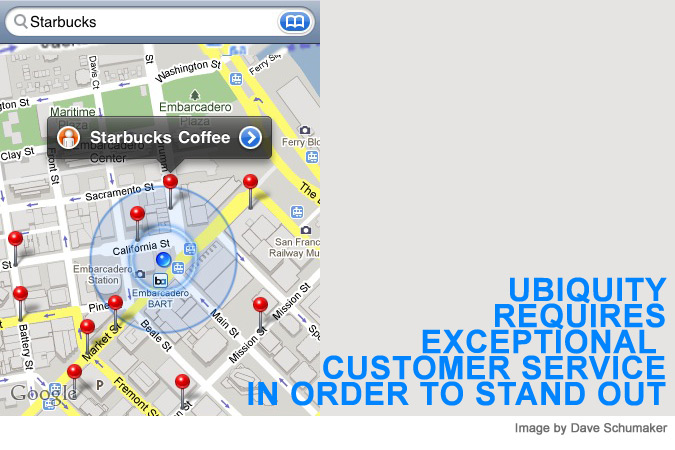There are some compelling statistics that show how keeping an existing customer is cheaper and more profitable than trying to get new customers:
- Acquiring a customer costs 5 to 10 times more than retaining one.
- A 5 percent increase in retention yields profit increases of 25 to 100 percent.
- Repeat customers spend, on average, 67 percent more.
- Twenty percent of customers account for 80 percent of total revenues.
So how does a business keep existing customers coming back, create powerful word-of-mouth marketing, and stand out from your competition?
How One Starbucks Store Stood Out From the Rest
I go to a lot of Starbucks stores, as well as a variety of other cafes. In college I managed a cafe, so I am always mindful of how well they operate and how the customers react to the store design, service and products.
Stopping into a Starbucks at Penn Station in New York City during morning rush hour is never a good idea. But I had a remarkable experience recently that showed how a single store can enable customers goals even in the worst of situations:
- Heavy competition.
Within Penn Station – there is another Starbucks several stores down from the one I went to, plus other bakeries, cafes and stores where you can get coffee. And that is just inside Penn station. Once you walk out on the street, there is practically a Starbucks on every other corner, plus other competition. - A distracted and apathetic customer.
At 8:30-9am (when I was in this Starbucks) the place is crowded with a long line of customers who are in the middle of their morning commute, about to step onto a subway or walk to their office. They just got off a long train ride, and need to get to the office to start their long day. The store is not all that big, and it is packed with people. They are wearing their winter coats, scarves & hats inside and carrying their laptops, purses and bags. It’s worth mentioning that New Yorkers don’t have the greatest reputation in the world for being patient!
How did this Starbucks stand out and create a remarkable experience? It wasn’t by offering a free sample, installing a TV to entertain customers while they waited, creating a poster with their mission statement, making employees wear ‘fun’ pins or hats, or hand out coupons. Instead they focused on satisfying the core goals of their customers:
- Fast service
- Quality product
This is how they did it:
- Put Customer Goals First
Someone who had to be the manager, greated each customer when the GOT IN line, not after they waited for 5 frustrating minutes. Why do I think this employee was the manager – because he hustled. - Create a System That Adapts to the Situation
The manager took their order almost immediately when people got in line, and used a headset to relay the order to another employee behind the counter who began working on it and communicated to the other baristas preparing orders. It should be noted that there were at least 12 other people in line ahead of the newest customer. So, while they are waiting for those 12 people to be rung up, their order is being prepared. The opposite is usually true at Starbucks – you wait in line to order, then wait in a separate line while they make your beverage. - Make it a Pleasant Experience
This system allowed the cashiers to do what they do best – great people, collect money & give change, and say farewell. Despite the rush, the cashier I went to was incredibly friendly and noticed he was to everyone on line ahead of me. Not only said thank you, but told people to enjoy the rest of their commute. Big smile too – you just don’t get this kind of service during rush hour in New York City!
I would bet that many cafe owners would read the above description and think that they do the same things: put customer goals first, serve them efficiently and in a friendly manner. But again and again I am at cafes where the employees don’t look customers in the eyes, never smile, mess up basic orders, and stay behind the counter and chat other employees even when the store is a mess.
Core Goals vs Ancillary Value
Stand Out by Helping
Many businesses try to stand out on price, trends or advertising. But each of these are a race that is hard to win, and impossible to sustain. Customers are fickle. If your key differentiator is based on price, trends or promotions, then you constantly have to fight to win this week’s battle, and are training customers that the key value you offer provides no unique value over what the competition will be doing next week.
What if the model flipped – that instead of forcing your way into their lives, you were the one resource that they welcomed into their lives. The business that your customers make time for, much like sports fans make time (hours a week) to follow their favorite teams, or how people will gladly wait in line at a Starbucks instead of ordering comparable products at less crowded venue.
How Can you Leverage the Web to Help Customers?
- Information: Increasingly, people use the web to research products and services before they buy – even when purchasing a product in-person at business that is not on the web. Be there to help your customers make a smart decision.
- Connection: Are your customers passionate about the products or services you provide? (If not, why not?) If so, find ways for them to connect with you, with like minded people, and with the types of experiences they value most. Social media is a key way to do this, and does not require you to build a platform or worry about how to train people on it.
If you don’t have a presence on the web, create a website, start a blog, and promote it anywhere your customers experience your brand.
Then branch off – connect with your market on social media platforms. Give existing customers a reason to connect with you and help non-customers find value in your brand.
Your customers spend most of their time outside of your store, not dealing with your services or products. Maximize your potential interactions with them by reaching them online.


